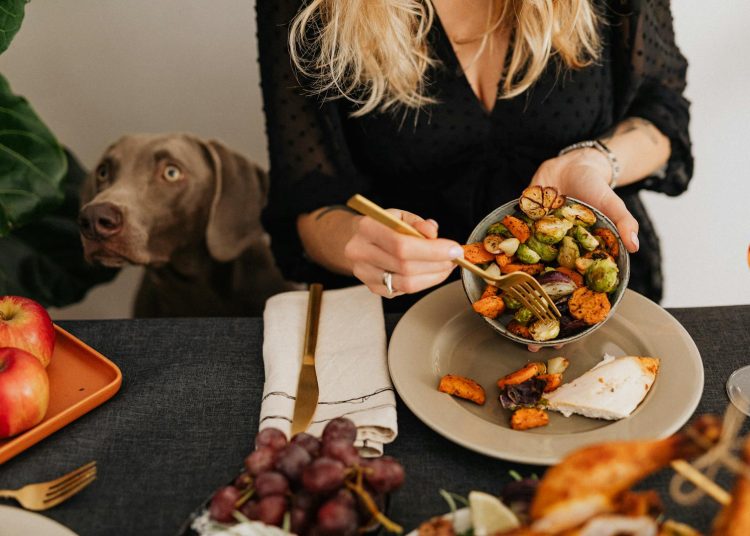Feeding your dog homemade meals can be a rewarding experience, providing your furry friend with wholesome, nutritious food tailored to their specific needs. Homemade dog food allows you to control the quality of ingredients and ensure that your dog receives a well-balanced diet without unnecessary additives or preservatives. If you’re looking to try your hand at making your dog’s meals, here are five easy, nutritious homemade dog food recipes that are sure to please your canine companion.
Recipe 1: Chicken and Rice Delight
This simple and balanced recipe is ideal for dogs with sensitive stomachs or those recovering from illness. It contains lean protein, healthy carbohydrates, and vegetables for added nutrition.
Ingredients:
- 2 cups cooked white rice
- 1 pound boneless, skinless chicken breast
- 1 cup mixed vegetables (carrots, peas, green beans)
- 1 tablespoon olive oil
Instructions:
- Boil the chicken breast in water until fully cooked. Once cooked, allow it to cool and shred it into small pieces.
- Cook the rice according to package instructions.
- Steam the mixed vegetables until tender.
- In a large bowl, mix the cooked rice, shredded chicken, and vegetables. Add the olive oil for a healthy fat source.
- Allow the mixture to cool before serving.
Benefits: This recipe is easy to digest and provides a good balance of protein, carbohydrates, and vitamins, making it perfect for dogs with digestive issues or those who need a mild diet.
Recipe 2: Beef and Sweet Potato Feast
Rich in protein and healthy fats, this beef and sweet potato recipe is great for active dogs who need extra energy to fuel their adventures.
Ingredients:
- 1 pound lean ground beef
- 1 large sweet potato, peeled and diced
- 1 cup spinach, chopped
- 1 tablespoon coconut oil
- 1/2 cup rolled oats
Instructions:
- In a skillet, cook the lean ground beef over medium heat until it is no longer pink. Drain any excess fat.
- While the beef is cooking, boil the sweet potato until soft.
- In a separate pan, heat the coconut oil and cook the spinach until wilted.
- Mix the cooked beef, sweet potato, spinach, and rolled oats in a large bowl.
- Allow the mixture to cool to room temperature before serving.
Benefits: This recipe is packed with protein from the beef, vitamins from the sweet potato and spinach, and healthy fats from the coconut oil. It’s ideal for dogs with high energy levels.
Recipe 3: Turkey and Quinoa Medley
This turkey and quinoa recipe is a great choice for dogs with grain sensitivities, as quinoa is a gluten-free, nutrient-rich alternative to traditional grains.
Ingredients:
- 1 pound ground turkey
- 1 cup quinoa
- 1/2 cup carrots, diced
- 1/2 cup zucchini, diced
- 1 tablespoon fish oil
Instructions:
- Rinse the quinoa thoroughly, then cook according to package instructions.
- In a skillet, cook the ground turkey over medium heat until it is fully cooked.
- Steam the carrots and zucchini until tender.
- Combine the cooked quinoa, turkey, and vegetables in a large bowl. Add the fish oil for omega-3 fatty acids.
- Let the mixture cool before serving to your dog.
Benefits: Quinoa is an excellent source of protein and fiber, and the added fish oil provides omega-3 fatty acids, which support skin and coat health. This recipe is especially beneficial for dogs with food allergies or sensitivities.
Recipe 4: Salmon and Brown Rice Bowl
This recipe is perfect for dogs that need extra omega-3 fatty acids for a healthy coat and joints. Salmon is an excellent source of high-quality protein and healthy fats.
Ingredients:
- 1 pound fresh salmon fillet
- 2 cups cooked brown rice
- 1/2 cup broccoli florets
- 1/2 cup green beans, chopped
- 1 tablespoon olive oil
Instructions:
- Preheat your oven to 350°F (175°C). Place the salmon on a baking sheet and bake for 15-20 minutes or until fully cooked.
- Cook the brown rice according to package instructions.
- Steam the broccoli and green beans until tender.
- Flake the cooked salmon, ensuring there are no bones, and mix it with the brown rice and vegetables.
- Add the olive oil to the mixture and let it cool before serving.
Benefits: Salmon is rich in omega-3 fatty acids, which are great for reducing inflammation and promoting a shiny coat. This recipe also provides complex carbohydrates and fiber for digestion.
Recipe 5: Lamb and Vegetable Stew
For a tasty and nutritious meal that your dog will love, try this lamb and vegetable stew. Lamb is a great protein source, especially for dogs with sensitivities to more common meats like chicken or beef.
Ingredients:
- 1 pound ground lamb
- 1 cup butternut squash, diced
- 1/2 cup green peas
- 1/2 cup celery, chopped
- 1 tablespoon flaxseed oil
Instructions:
- In a large skillet, cook the ground lamb over medium heat until browned. Drain any excess fat.
- Boil the butternut squash until soft.
- Steam the peas and celery until tender.
- Mix the cooked lamb, squash, peas, and celery in a large bowl. Add the flaxseed oil for additional omega-3 fatty acids.
- Allow the mixture to cool before serving.
Benefits: Lamb is a good source of protein for dogs with food sensitivities, and butternut squash provides vitamins A and C. The added flaxseed oil supports skin and coat health, making this recipe a well-rounded meal.
Tips for Making Homemade Dog Food
- Consult Your Veterinarian: Before transitioning your dog to a homemade diet, consult your veterinarian to ensure the recipes meet your dog’s specific nutritional needs. Homemade meals can sometimes lack certain essential nutrients, so your vet may recommend supplements.
- Balance Is Key: Dogs require a balance of protein, fats, carbohydrates, vitamins, and minerals. Ensure that your homemade recipes include all these components to keep your pet healthy and thriving.
- Introduce New Foods Gradually: If you’re introducing new ingredients to your dog’s diet, do so gradually to avoid gastrointestinal upset. Monitor your dog for any adverse reactions, such as vomiting or diarrhea.
- Portion Control: Be mindful of portion sizes to avoid overfeeding. Homemade food can be calorie-dense, and it’s important to maintain a healthy weight for your dog.
- Storage: Store homemade dog food in an airtight container in the refrigerator and use it within 3-4 days. You can also freeze portions for future use, ensuring your dog always has a fresh meal ready to enjoy.
Final Thoughts on Homemade Dog Food
Making homemade dog food is a wonderful way to provide your dog with nutritious and delicious meals. It allows you to control the ingredients and tailor the diet to your dog’s needs, ensuring they receive the best care possible. With these five recipes, you can give your dog a variety of flavors while ensuring they get the essential nutrients they need for a healthy life.








